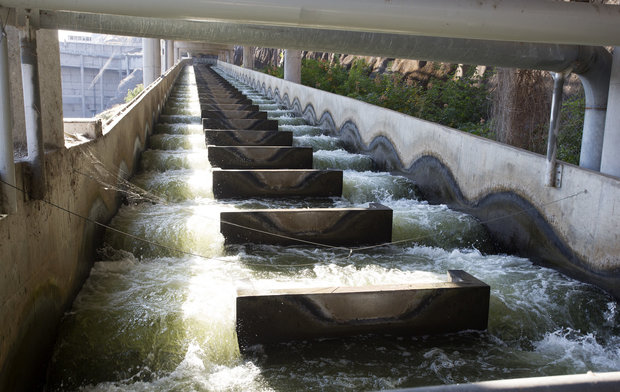forum
library
tutorial
contact

Ingenuity Needed on Salmon
by Editorial BoardThe Daily Astorian, March 12, 2020
|
the film forum library tutorial contact |

|
Ingenuity Needed on Salmonby Editorial BoardThe Daily Astorian, March 12, 2020 |
 'Hollow regret is all we can offer to the species we've hustled off into extinction -- from the clouds of passenger pigeons that once filled America's skies to the faintly ridiculous dodo birds of the Indian Ocean island of Mauritius. If wild salmon and steelhead are to avoid the same fate, meaningful decisions must be made now."
'Hollow regret is all we can offer to the species we've hustled off into extinction -- from the clouds of passenger pigeons that once filled America's skies to the faintly ridiculous dodo birds of the Indian Ocean island of Mauritius. If wild salmon and steelhead are to avoid the same fate, meaningful decisions must be made now."
Since we wrote those words in 2006 there have been a few fairly decent years for salmon returning to spawn in the Columbia-Snake watershed. There also have been dismal years, as 2020 is shaping up to be.
Fourteen years ago, we were confident that part of the answer is restoring a free-flowing lower Snake River:
"Thanks to relatively effective fish ladders and other expensive mitigation measures, even damming the Columbia hasn't proven fatal to the tough and tenacious salmon whose overriding biological imperative drives them upstream. No, it was the Snake River dams -- the last four forced through the door before the nation wised up to the true costs of dams -- that sent salmon into the downward spiral we witness today."
We observed that wild salmon teeter on a filleting knife's edge, with much riding on unpredictable ocean conditions.
"Posterity will judge us not on how cheaply we produced electricity, or how efficiently we operated a barge system to Lewiston, Idaho. Ten generations from now, our descendants will admire us or deplore us for decisions today about whether salmon survive or perish."
It might not have been excessively cynical to wonder a couple of decades ago whether powerful economic interests were playing a delaying game, dragging their institutional heels when it came to meaningful action, at least hoping that wild salmon runs would collapse into extinction and thus eliminate the need for bypassing dams.
In reality, most people in the Northwest are willing to make sacrifices to help salmon. But as a new federal report makes clear, bypassing the Snake River dams helps salmon but comes with significant downsides. That the report comes out of the science-averse Trump administration will cause some skepticism. But taking the current political environment into account, it seems reasonably candid. The doubts it raises about reverting the Snake to free flows will provide plenty of cover for taking less ambitious steps.
Even among Washington state's progressive upper echelon of politicians, there is discomfort at the idea of undamming the Snake. Everyone from the powerful wheat lobby to union members employed in river-borne commerce would scream murder. In a time when we're trying to eliminate fossil-fuel electricity, cutting back a significant source of hydropower would appear counter to conventional wisdom -- even among urban voters with a hypothetical love for wild salmon.
The equation for dam breaching is also substantially altered by the seismic shift in federal courts in the past three years. Loaded with more business-friendly trial and appellate judges, the odds for positive outcomes have lessened for litigants in all kinds of environmental challenges. Even a change in president after this year's election -- if such a change occurs -- wouldn't make any near-term difference.
Salmon aren't dodos. Superbly adapted to their environment, they thrived for thousands of years after the arrival of humans here in the Pacific Northwest. Even after the 19th century's decades of free-for-all harvesting, many Columbia-Snake salmon runs survived in numbers that make even the best returns today pale in comparison.
However much salmon runs once fluctuated before dams -- perhaps due to natural ocean phenomena like El Niños -- they've never had to overcome challenges like those arising in our times. Rapid changes in ocean chemistry, currents and temperatures mean that salmon spend a majority of their lives in a setting increasingly unlike the one in which they evolved. This can result in poor rates of survival and return despite all the meaningful steps that have been taken to restore freshwater habitat. Predator control, though controversial, also offers some continuing prospect for incrementally improving salmon survival.
Since bypassing dams appears unlikely anytime soon, what more can be done to help salmon, and the fishermen and orcas that depend on them? The new federal report offers little more than paltry suggestions centering on an incremental increase in "spills" -- water earmarked for aiding salmon migration.
If altogether bypassing dams is off the table, far more aggressive secondary actions will be required. Finding such solutions will require ingenuity coupled with regional cooperation, possibly including costly and comprehensive engineering fixes that provide alternative pathways for migrating salmon.
This is not a time for timid half steps. If there was a "Doomsday Clock" for wild salmon like there is for nuclear war, a firm decision to leave the Snake River dams untouched moves the hands within seconds of midnight.
learn more on topics covered in the film
see the video
read the script
learn the songs
discussion forum
